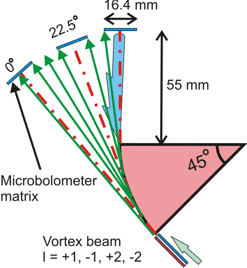
First Generation of Surface Plasmon Polaritons via Diffraction of Monochromatic Terahertz Beams with Angular Orbital Momentum on the Sample Edge
Beams with orbital angular momentum (or vortex beams) are subjects of special interest in modern optics. Recently a paper [1] has been published, in which surface plasmon microvortices in the visible spectral range were generated on a silver film via formation of concentrically converging surface plasmon polaritons (SPPs). In this paper we describe generation of terahertz SPPs travelling azimuthally on Au-ZnS-air cylindrical interfaces (ZnS thickness changed from 0.3 to 2 μm), using vortex beams. Gaussian beam of Novosibirsk free electron laser with a wavelength of 141 μm illuminated a silicon spiral phase plate, which formed at a distance of about 100 mm a beam with orbital angular
momentum (E(φ )~exp{ilφ}, where φ is the polar angle). In our experiments the vortex beams with the topological charges l = +1, -1, +2, -2 and first maximum diameters of 1.8 and 2.6 mm, respectively, were generated. These beams can be classified as non-diffractive beams, because their intensity spatial distributions did not changed for a path length in the free space of 160 mm. Pointing the center of vortex beam at the edge of the π/4 cylinder segment (Figure 1), we generated SPPs via diffraction (see [2]). Both diffraction patterns of vortex beams and SPP produced, in contrast to the case of non-vortex beams, were non-symmetric relatively the beam axis. Detecting with a movable mictobolometer matrix free radiation emerging by SPPs diffracted at the output cylinder edge and tangential radiation losses of SPP travelling along curved surface, we have studied efficiency of SPP generation and specific features of surface plasmon polaritons produced with vortex beams.
)~exp{ilφ}, where φ is the polar angle). In our experiments the vortex beams with the topological charges l = +1, -1, +2, -2 and first maximum diameters of 1.8 and 2.6 mm, respectively, were generated. These beams can be classified as non-diffractive beams, because their intensity spatial distributions did not changed for a path length in the free space of 160 mm. Pointing the center of vortex beam at the edge of the π/4 cylinder segment (Figure 1), we generated SPPs via diffraction (see [2]). Both diffraction patterns of vortex beams and SPP produced, in contrast to the case of non-vortex beams, were non-symmetric relatively the beam axis. Detecting with a movable mictobolometer matrix free radiation emerging by SPPs diffracted at the output cylinder edge and tangential radiation losses of SPP travelling along curved surface, we have studied efficiency of SPP generation and specific features of surface plasmon polaritons produced with vortex beams.
[1] H. Kim, J. Park, S. Cho et al. Nano Lett. 10, 529-536 (2010).
[2] V. Gerasimov, B. Knyazev, I. Kotelnikov, A. Nikitin. Paper submitted at this conference.
ba_knyazev@phys.nsu.ru
Powered by Eventact EMS